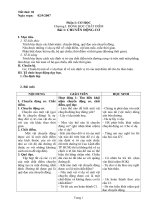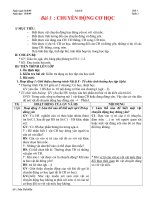Bài giảng Bài 1: Dẫn nhập y hoc (EBM) y tế công cộng (EBPH) dựa vào chứng cứ
Bạn đang xem bản rút gọn của tài liệu. Xem và tải ngay bản đầy đủ của tài liệu tại đây (4.62 MB, 86 trang )
BÀI 1. DẪN NHẬP
Y HOC ( EBM) / Y TẾ CÔNG CỘNG
( EBPH) DỰA VÀO CHỨNG CỨ
GS TS BS LÊ HOÀNG NINH
Nội dung cốt lõi
• Tại sao y hoc chứng cứ là quan trọng
• Y học chứng cứ là gì ?
• Phân biệt foreground vs. background
questions
• Đặt câu hỏi dạng PICO
• Tìm nguồn tư liệu
• Giá trị của một bào báo khoa học y học / sức
khoẻ
• Đánh giá các dạng bài báo : can thiệp điều trị
/ dự phòng; chẩn đoán/ sàng lọc; nguyên
nhân…
Tại sao EBM là quan trọng?
• MEDLINE
– 400,000 new entries added each year
• To keep up-to-date
– Need to read 6,000 articles each day
Tại sao EBM là quan trọng?
sự chậm trễ “ từ lúc biết cho tới lúc
áp dụng”
– 13 years for thrombolytic therapy
– 10 years for corticosteroids for
acceleration of fetal lung maturity
(Antman EM, JAMA, 1992)
Traditional Approaches
Self-reported reading time per week.
(University setting)
– Medical students 60 min.
– Interns none
– Senior residents 10 min.
– Fellows 45 min.
– Attendings graduating
• Post 1975 60 min.
• Pre 1975 30 min.
There is simply no way we
can keep up to date in
medicine using traditional
approaches!
Nội dung cốt lõi
• Why is EBM important?
• What is EBM?
• Understand foreground vs. background
questions
• Formulate PICO questions
• Find resources, do searches
• Validity of an article
• Appraise “Therapy” articles
• Appraise “Diagnostic” articles
Research Evidence
Clinical Expertise
Patient Preference
Decision Making
Qui
trình
y học chứng cứ / y tế công cộng
Patients
Ask Questions
SearchingAppraise
Validity Results Applicability
Nội dung cốt lõi
• Why is EBM important?
• What is EBM
• Understand foreground vs. background
questions
• Formulate PICO questions
• Find resources, do searches
• Validity of an article
• Appraise “Therapy” articles
• Appraise “Diagnostic” articles
What’s the difference
between foreground and
background questions?
Asking the Precise Question
• Background questions
• Basic aspect of a
disease
• Pathophysiology
• Etiology
• Basic treatment
• Who, what, when, how
• Foreground questions
• Specific knowledge
• Have 4 parts:
•Patient/problem
•Intervention
•Comparison
intervention
•Clinical outcomes
Background or Foreground?
• What is asthma?
• Is prednisone helpful in asthma?
• What are the newest medication for
asthma?
• Does atrovent used acutely make you
feel better?
Background or Foreground?
• What is asthma? (B)
• What are the newest medication for asthma?
(B)
• Does atrovent used acutely make you feel
better? (F)
• Is prednisone helpful in asthma? (F or B)
• Foreground if compare to other drugs
• Background if interested in how it works
Nội dung cốt lõi
• Why is EBM important?
• What is EBM
• Understand foreground vs. background
questions
• Formulate PICO questions
• Find resources, do searches
• Validity of an article
• Appraise “Therapy” articles
• Appraise “Diagnostic” articles
Structure of a Well-built Question
• Patient or population
• Be specific to capture the group you want
• Ex: Children w/ asthma
• Intervention
• Be specific
• Comparison group (if any)
• Compare to standard therapy or test
• Outcome
• Be precise
• What are the outcome of interest
Patient Intervention
Comparison
(if relevant)
Outcome
In patients with
asthma discharged
home from the
emergency
department
does the use of
both inhaled and
oral corticosteroids
compared with
oral steroids
alone
lead to a
reduction in
asthma relapse?
Formulating the Clinical Question
PICO
Can You Identify PICO?
• In children under 6 months, how does
sleeping on back compared to sleeping on
the stomach in terms of risk of SIDS?
• In children under 6 months (P), how does
sleeping on back (I) compared to sleeping on
the stomach (C) in terms of risk of SIDS (O)?
Can You Form a PICO Question?
Clinical scenario:
5 yo with moderate persistent
asthma now in severe acute asthma
exacerbation. Intern gave 2 albuterol
and orapred with minimal
improvement. Intern asks why how
good is atrovent?
Searchable PICO Question
P: Population
I: Intervention/diagnostic test/risk
factor
C: Comparison
O: Outcome
In children with acute asthma exacerbation
(P), will the addition of atrovent (I) to
albuterol (C) decrease the rate of
hospitalization (O)?
Nội dung cốt lõi
• Why is EBM important?
• What is EBM
• Understand foreground vs. background
questions
• Formulate PICO questions
• Find resources, do searches
• Validity of an article
• Appraise “Therapy” articles
• Appraise “Diagnostic” articles
Searching Superhero
Best Bets
The Evidence Pyramid
If your question is about… Look for a …
Intervention/Therapy • Randomized controlled trial
Diagnosis/Screening
To assess the accuracy of the test
To assess effect of test on health
outcome
• Cohort study
• Randomized controlled trial
Prognosis •Longitudinal cohort
Etiology/Risk factors • Randomized controlled trial
• Cohort
• Case-control









